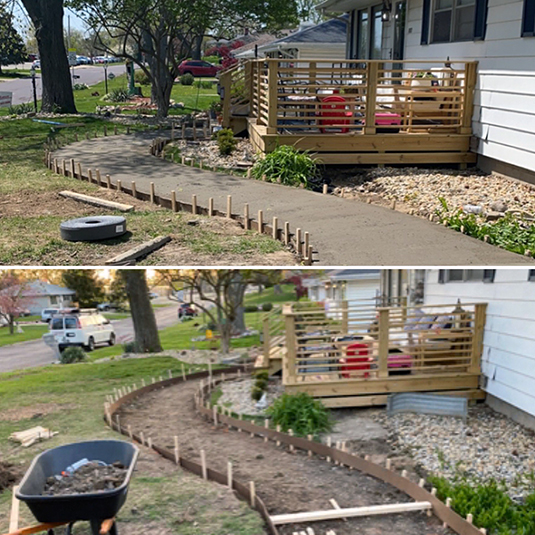
Preparing a Walkway for Concrete
Form and pour a new concrete sidewalk, the perfect first concrete project for the beginner. Replace that ugly, cracked walk with a flat, smooth new one. We show you how to build forms and then place and smooth the wet concrete, all with first class results. You save big money too.
Tools Required
- Bull float
- Circular saw
- Drill/driver - cordless
- Edger
- Garden rake
- Gloves
- Hammer
- Plate compactor or tamper
- Shovel
- Sod cutter or flat shovel
- Utility knife
- Wheelbarrows (2 minimum)
Materials Required
- 1 2-in. wide Wood stakes
- 1-1/4-in. screws
- 4-mil Plastic sheeting
- Gravel
- Hardboard siding or Masonite board
- Spray paint
Planning and Tools
If the thought of pouring concrete scares the bejeebers out of you, don’t feel like the Lone Ranger. This will teach you the basics, so you’ll be confident and ready to go when the concrete truck pulls up to the curb. And you’ll save the concrete walkway cost of hiring concrete pros.
Concrete might be the cheapest building material on the planet. It’s hard to imagine a material that gives more bang for the buck than concrete for the cost of sidewalk. What other material yields a permanent, finished, durable, maintenance-free outside surface at a low cost and a day’s work? Around these parts, many contractors won’t put down a gravel base.
You may need a building permit—check to be sure. At our home, we didn't need a building permit for a residential sidewalk on private property. But take five minutes and call your local building inspector to make sure that's true in your area. You'll save some embarrassment and possibly a fine. Stick to sidewalk projects in flat or gently sloping areas. Adding steps is much more complicated.
You're going to need a couple of heavy-duty wheelbarrows, shovels, rakes and a variety of professional-grade concrete tools. We describe the tools in detail below. For a modest price, you can own a set of high-quality tools (minus the wheelbarrows) for life and not have to hassle with rentals. Once the ready-mix truck (the concrete is premixed and ready to pour) shows up, you and your helpers will be muscling around 200-lb. wheelbarrows over gravel. This work is intense—you won't be taking any coffee breaks for a while.
Map Out Walkway
Digging out the path is 80 percent of the job. Lay out the path with 6-in. ripped strips of Masonite tacked to temporary stakes. Flex it to the desired shape of your sidewalk and stake it down. That'll not only give you the overall shape but also provide the forms to mark the outline for digging. Use marking paint (upside down spray paint) to mark the ground next to the form. To outline the sidewalk for digging, mark the unformed side using a spacer block.
Dig Walkway
It took two of us a whole day to cut off the sod and dig out the path to prepare the base for this sidewalk. Tree roots, stones and heavy clay made for tough digging. Renting a sod cutter or excavator will help dramatically and using axes for cutting out roots and pickaxes to loosen soil make the job a little less blister-producing.
Start thinking about drainage issues at this point. If water tends to collect in the yard in spots, you may want to elevate the walk in those areas, so don't dig as deeply there. Long, flat areas should have one side of the sidewalk lower so water can drain off the side.
Slice off sod with a sod cutter or excavator, then dig out the rest of the sidewalk path to a depth of 6 in. Dig out about 3 in. wider on both sides of the paint marks to leave room for forms. Set aside some topsoil to fill against the forms and sidewalk later.
Build the Forms
Use masonite to form even the tightest curves. Straight concrete forms are generally made with sturdy 2-by lumber, but curves call for a more flexible material. Full-service lumberyards and home centers carry all this forming material as well as reinforcing mesh and expansion strips you'll need. Roughly measure the length of the walk and divide it by 16 to get the number of siding pieces needed. Masonite’s cheap, so buy an extra length to make sure you have enough.
Also, pick up enough wood stakes to anchor each side of the form every 3 ft., a 1-lb. box of 1-1/4 in. drywall screws for anchoring the forms to the stakes and enough 6-in. Pound in two stakes about 1 ft. from the ends of the form positions. Screw the forms to the inside of the stakes with a couple of 1-1/4 in. drywall screws. Bend the forms to make smooth curves, anchoring them with more stakes every 3 ft. Keep the tops of the forms about 1 in. above the cut grass height for easy mowing and a nice appearance.
Spread Rock Base
For a long-lasting sidewalk, plan on a 3-in. base of gravel under 4 in. of concrete. Gravel protects concrete from these shifting conditions. Just about any gravel works well, but 3/4-in. crushed rock is easy to shovel and packs well so you can run heavy wheelbarrows on it without the wheels bogging down. Gravel is ordered by weight, not volume like concrete. Divide the gravel volume by 1.4 to calculate the tonnage to order. Spread gravel 3 in. deep between the forms. Pack dirt against the outside and gravel against the inside of forms to add support when pouring and to achieve smooth curves. It’s not necessary to compact the gravel.
From this point on I left the concrete to the professionals! I saved a lot of time and money doing some of this myself. Preparing the space really taught me a lot. I love to design and landscape a space. From my mind to paper and from paper to reality.